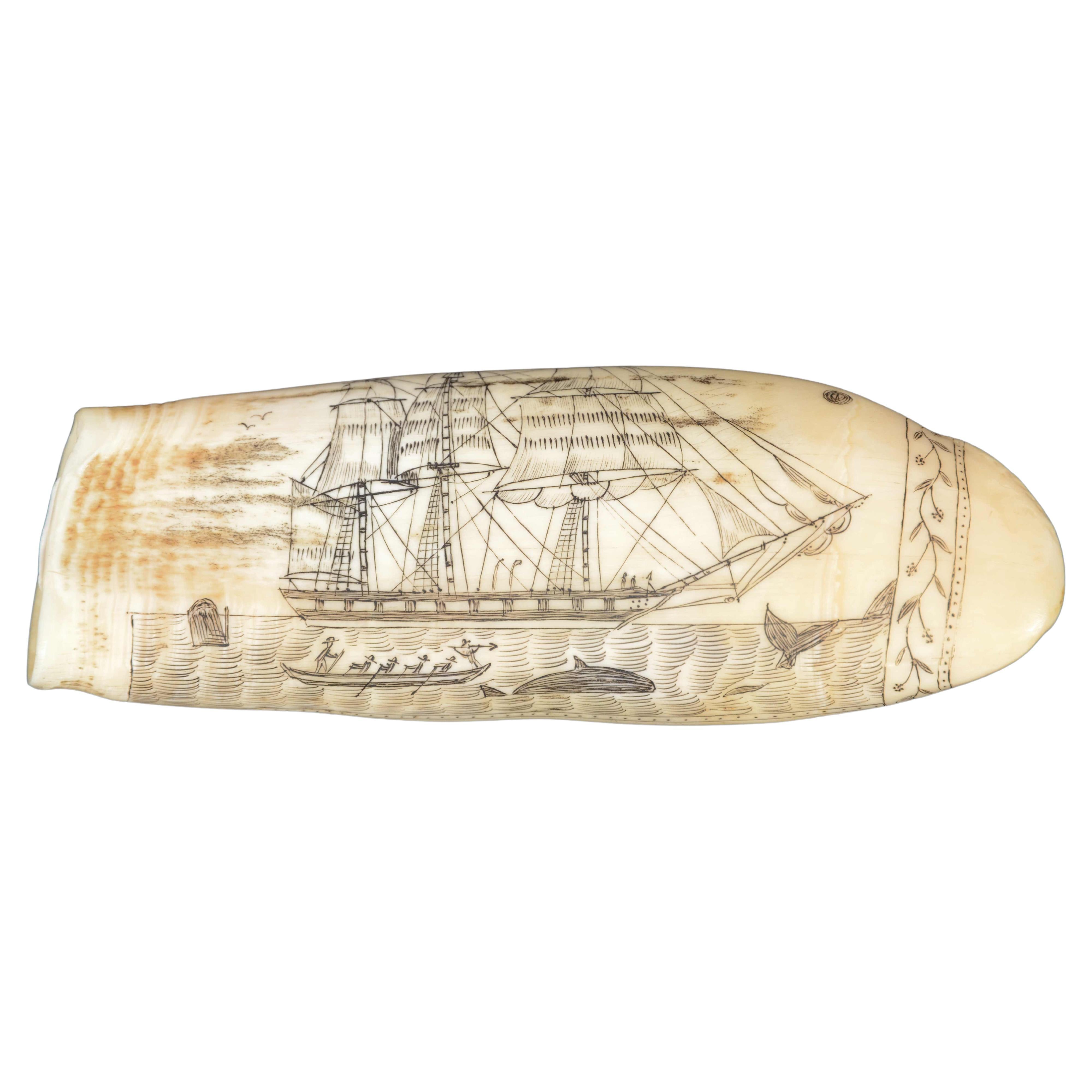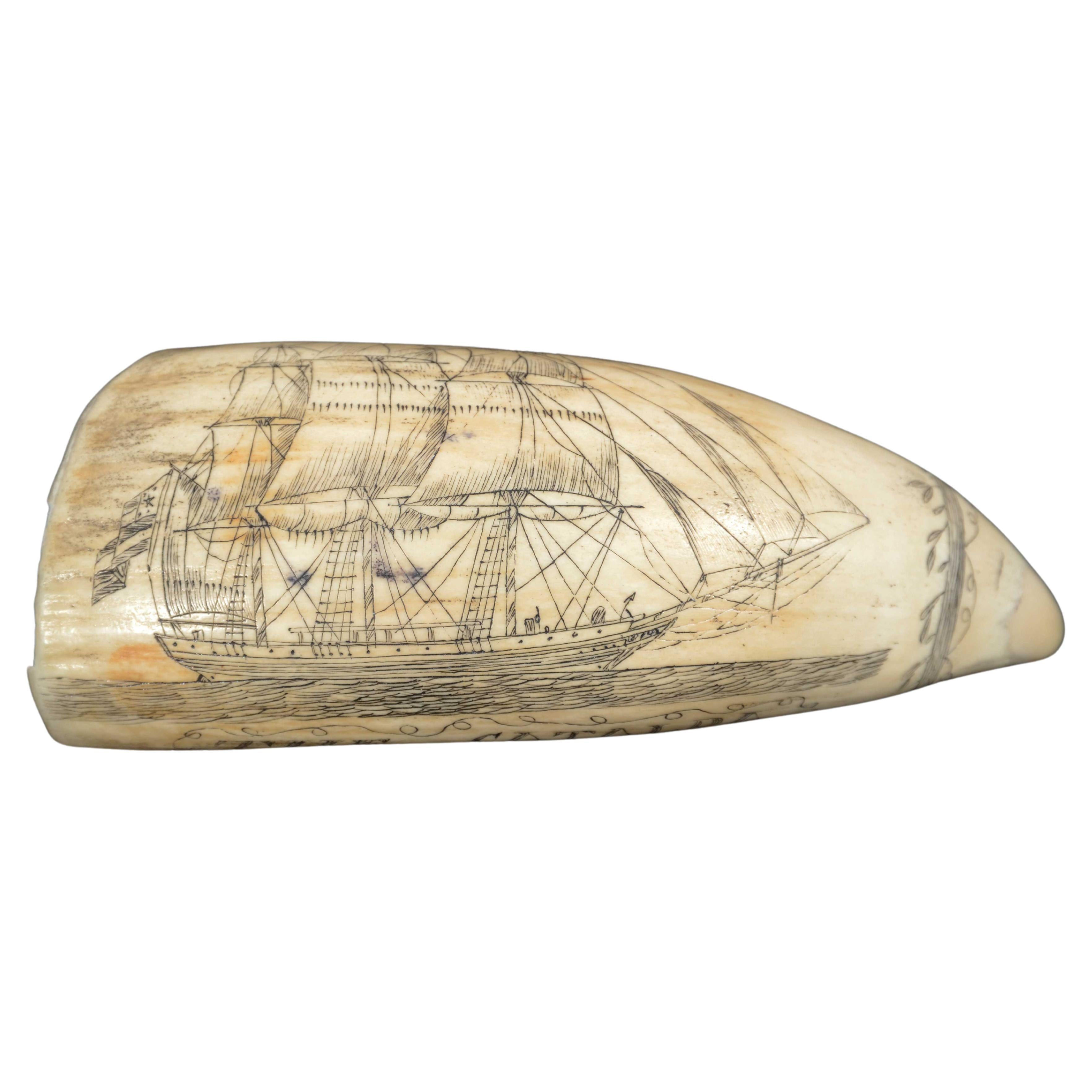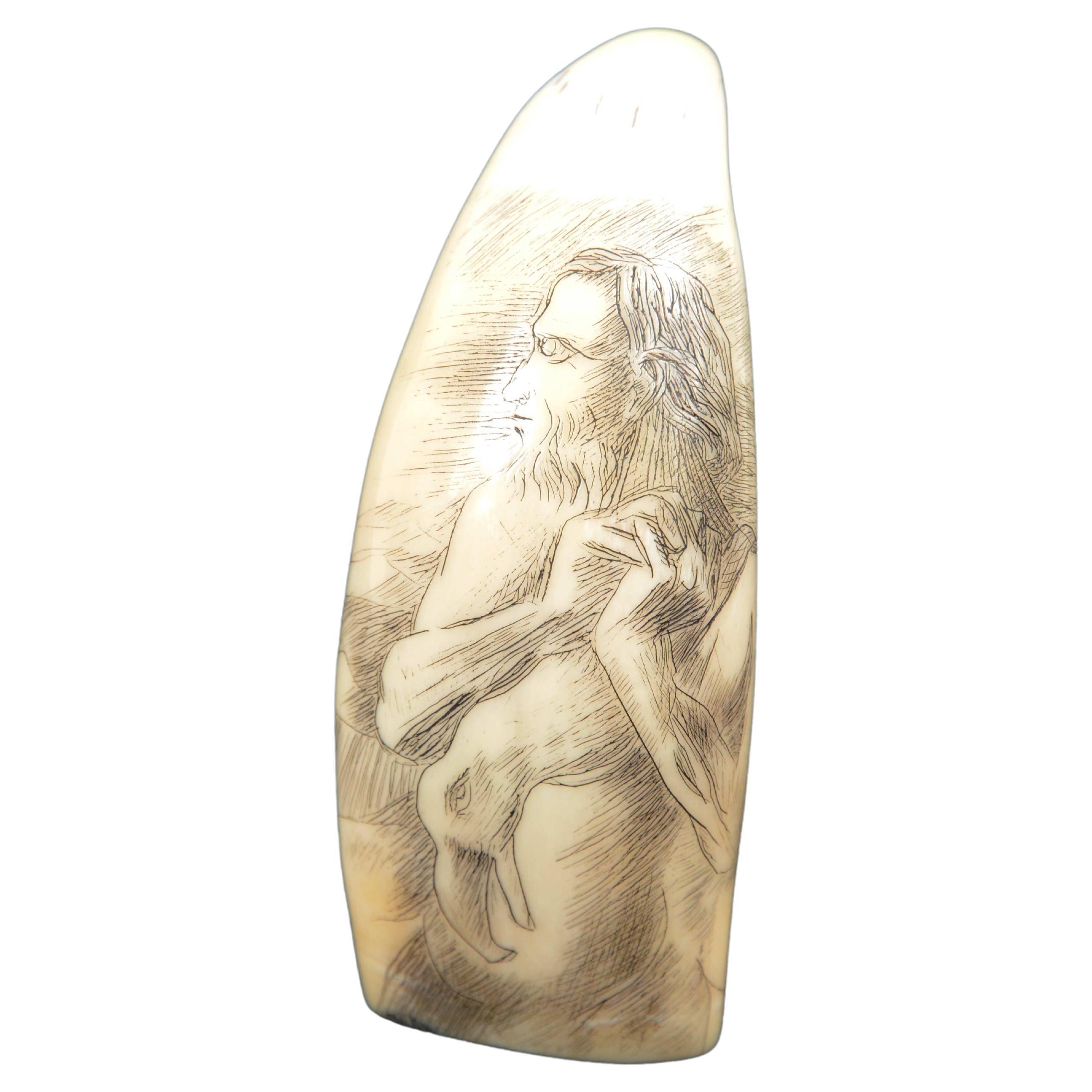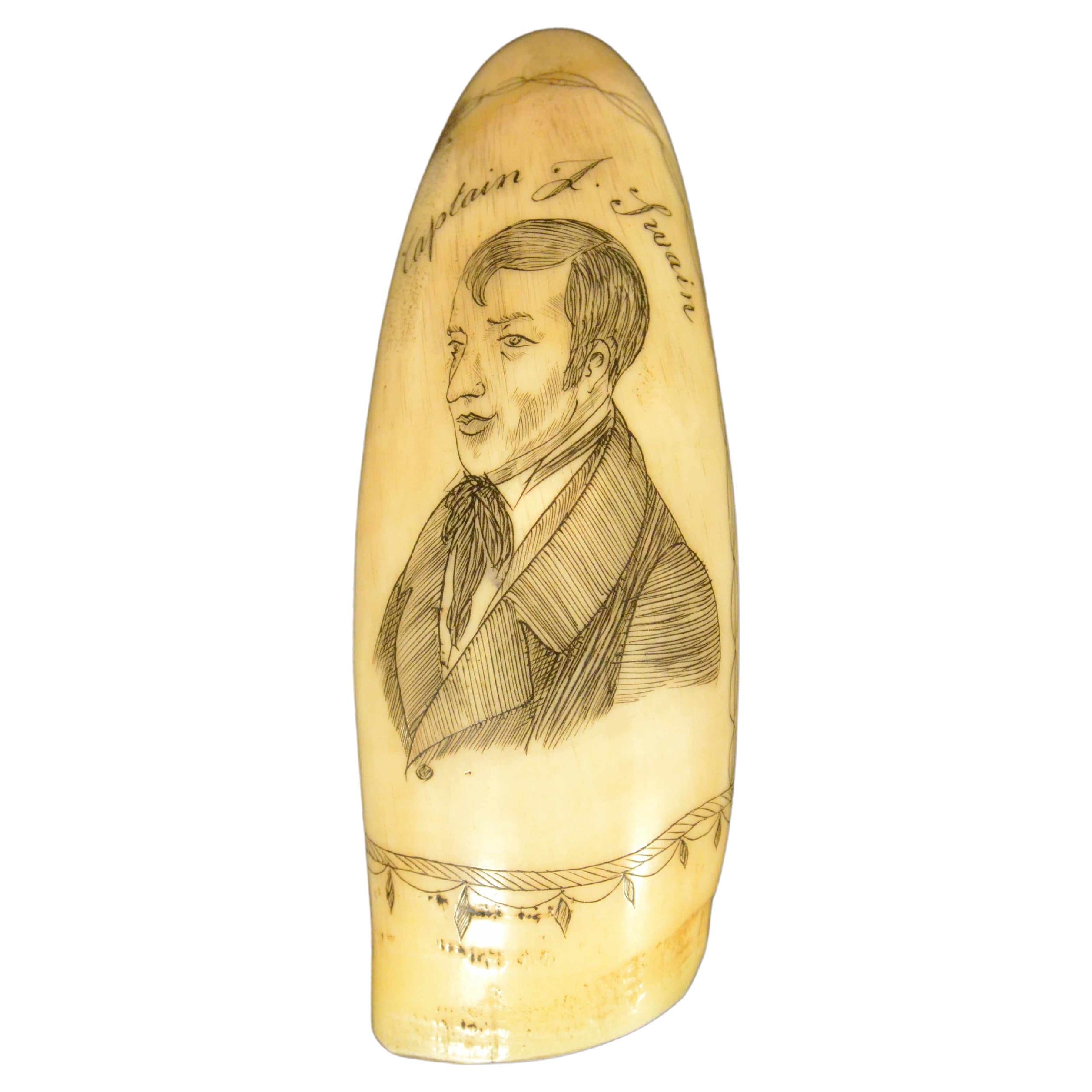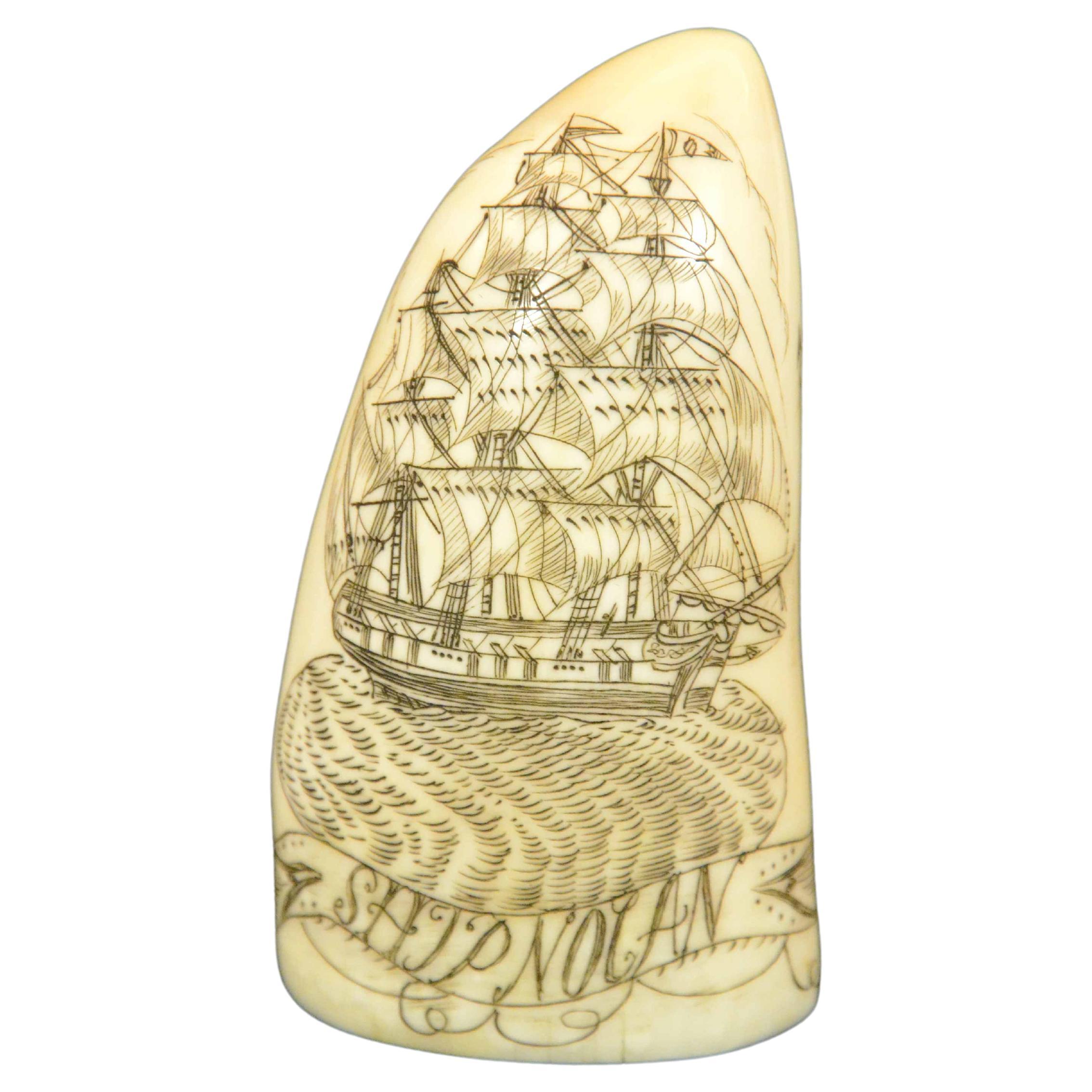Items Similar to Scrimshaw whale tooth engraving of fine workmanship dated around 1850
Want more images or videos?
Request additional images or videos from the seller
1 of 11
Scrimshaw whale tooth engraving of fine workmanship dated around 1850
About the Item
Scrimshaw of an engraved whale tooth, of fine workmanship datable to around the mid-19th century, length 10.8 cm, depicting small rowing boat with sail and 6 men on board, one of them in the act of harpooning a whale larger than the boat. On the sail is marked No. 1. On the back of the tooth is engraved with the following phrase: Crew of the Nonsuch about to fasten to a Sperm Whale.
Good original patina condition. Measures 10.8x4.5x3- inches 4.5x1.6x1.4.
The last photo is the gift box.
The word "scrimshaw" refers to an art form (and the various products of this art) that developed aboard American whaling ships between 1745 and 1759 as a means of entertainment to occupy time during the long hours aboard; this art form consisted of a process of carving and engraving whale bones and teeth, with which a wide range of both everyday and ornamental objects were made, which were usually made as souvenirs for members of one's family. Nella scelta dei materiali il primo era sicuramente il dente d'avorio del capodoglio. Solo la punta del dente era liscia ed era necessario preparare il resto della superficie ruvida lucidandola. Il dente era ben immerso in acqua salata o calda, spesso con l'aggiunta di potassio. Quindi veniva utilizzata una lima per strofinare e arrotondare la superficie, e infine una carta vetrata fine per completare il processo. L'ultima fase della lucidatura veniva eseguita con pomice o cenere e poi il dente veniva strofinato ancora con il palmo della mano. Each step had to be performed very slowly so as not to affect the smooth surface of the tooth. In terms of subjects for scrimshandering, the most common were a drawing of a ship or scenes of cetacean capture, made with a needle or knife, or an appropriate blade: for example, thanks to Herman Melville we know that some whalers had boxes of dentist's tools specially designed for scrimshandering. The origin of scrimshandering, as the whalers called it, i.e., the art of making scrimshaw, is a mystery: theories range from locating its origin in Eskimo culture or with Native Americans to emphasizing the influence of South Sea islanders. La spiegazione di Edouard A. Stackpole (1903 -1993), giornalista americano, scrittore e storico di caccia alle balene, è forse la più plausibile: lo scrimshaw sarebbe stato semplicemente lo sviluppo marittimo dell'antica arte di intagliare l'avorio, così come era stata praticata per secoli, e in quanto forma d'arte popolare non sarebbe stato altro che un adattamento da parte dei balenieri americani di un antico mestiere.
- Dimensions:Height: 4.5 in (11.43 cm)Diameter: 1.6 in (4.07 cm)
- Materials and Techniques:Teeth
- Period:
- Date of Manufacture:1850
- Condition:Wear consistent with age and use.
- Seller Location:Milan, IT
- Reference Number:1stDibs: LU1020237324922
About the Seller
4.9
Vetted Seller
These experienced sellers undergo a comprehensive evaluation by our team of in-house experts.
Established in 1999
1stDibs seller since 2014
370 sales on 1stDibs
Typical response time: <1 hour
- ShippingRetrieving quote...Ships From: Milan, Italy
- Return PolicyA return for this item may be initiated within 14 days of delivery.
More From This SellerView All
- Engraved whale tooth scrimshaw of fine workmanship datable around 1850Located in Milan, ITScrimshaw of an engraved whale tooth, fine workmanship datable to around mid-19th century, length 11.7 cm, depicting whaler with men aboard, boat rowing with 6 whalers one of them i...Category
Antique 1850s Nautical Objects
MaterialsTeeth
- Scrimshaw of excellently made engraved whale's tooth dated around 1850Located in Milan, ITScrimshaw of an engraved and beautifully crafted whale tooth dated around the mid-19th century depicting vessel with full sails under sail, on the back a lady in a long dress with in...Category
Antique Mid-19th Century Nautical Objects
MaterialsTeeth
- 7990 Scrimshaw of vertically engraved whale tooth dated around 1850Located in Milan, ITScrimshaw of a vertically engraved whale tooth datable to around the mid-19th century depicting an old sailor with a beard and long hair holding leaning over one shoulder a cormoran...Category
Antique 1850s Nautical Objects
MaterialsTeeth
- Scrimshaw of vertically engraved whale tooth valuable workmanship dated 1882Located in Milan, ITScrimshaw of a vertically engraved whale tooth, of fine workmanship dated 1882, length 12 cm - inches 4.8. The tooth depicts: 6 whalers in rowboat trying to harpoon a whale and whal...Category
Antique 1880s Nautical Objects
MaterialsBone
- Scrimshaw of engraved whale tooth depicting the Captain F. Swain 1850Located in Milan, ITScrimshaw of an engraved whale tooth, depicting on one side the half-bust of the smartly dressed and handsome Captain F. Swain. On the Back the inscription Master The WHALER SWAN f...Category
Antique Mid-19th Century Nautical Objects
MaterialsTeeth
- Scrimshaw of an engraved whale tooth dated 1861 depicting SHIP NOLANLocated in Milan, ITScrimshaw of an engraved whale tooth dated 1861, depicting on one side large sailboat with sails unfurled of excellent workmanship and underneath the name SHIP NOLAN. On the back, a ...Category
Antique 1860s Nautical Objects
MaterialsTeeth
You May Also Like
- 19th Century Irish Folk Art Whale ToothLocated in Coeur d'Alene, IDIrish Folk Art. This sperm whale tooth was etched during the 19th century, in Ireland. There'sa a drinking sailor on one side, and a barmaid on the other -...Category
Antique Late 19th Century Northern Irish Nautical Objects
MaterialsOther
- Rare Scrimshaw Decorated HornLocated in Lymington, HampshireA rare scrimshaw decorated horn, engraved over one side with the Royal Arms countersigned and titled ship profiles for the Great Eastern, the Great Britain,...Category
Antique 1860s English Nautical Objects
MaterialsHorn
- Antique Lithography Map, Cornwall, English Framed Engraving, Cartography, C.1850Located in Hele, Devon, GBThis is an antique lithography map of the Duchy of Cornwall. An English, framed atlas engraving of cartographic interest, dating to the early 19th century and later. Superb lithogra...Category
Antique Mid-19th Century British Victorian Maps
MaterialsWood
- Fine Pair of Floor Globes by J & G Cary, Dated 1820 and 1833By George & John CaryLocated in Lymington, HampshireA fine pair of 15 inch floor globes by J & G Cary, dated 1820 and 1833, each set into a mahogany stand with a vase shaped support and three legs centred on a compass, one with a labe...Category
Antique Early 19th Century English Regency Globes
MaterialsMahogany
- Fine Chinese Blue and White Porcelain Spoon, c. 1850Located in Chicago, ILA delicate example of the time-honored practice of blue-and-white ceramics, this 19th century porcelain soup spoon was likely used as an everyday ...Category
Antique Mid-19th Century Chinese Qing Ceramics
MaterialsPorcelain
- Fine Pair of Bronze Cannon by McAndrew and Woore English, circa 1850Located in Lymington, HampshireA fine pair of bronze cannon by McAndrew and Woore, set on their original brass bound black painted oak carriages with brass spider wheels, also with a p...Category
Antique 1850s English Arms, Armor and Weapons
MaterialsBronze
Recently Viewed
View AllMore Ways To Browse
Perer Alexander
Smiths Vintage Collectable Clocks Vintage Collectable Clocks
Maniglia Ottone
Vintage Paddles Oars
Edwin Levick
Fuji Binocular
Navigation Dividers
Royal Navy Telescope
Star Navigation
Vintage Shipwrights Tools
Sail Boat Wood Toy
Collier Bakelite
Nikon Ww11
Siemens Telegraph
Silvani Brighton
Sterling Boating Trophy
Vintage Airguide
Vintage Fishing Net Floats
